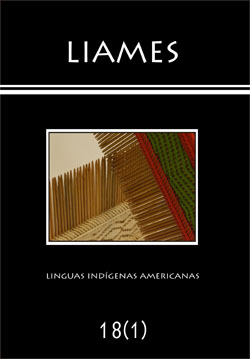Resumo
The present paper describes and illustrates the main naming strategies attested in a lexical database of 1233 Kakataibo names of plant and animals. Seven naming strategies are proposed for Kakataibo ethnobiological nomenclature: coining, morphological derivation, borrowing, ethnobiological polysemy, compounding and grammatical nominalization (the latter two being exclusively associated with lexically complex forms). Kakataibo ethnobiological terminology overally follows the general word-formation patterns available in the language, but it will be argued that some types of compounds and grammatical nominalizations found in the database are constraint to names of plants and animal. Indeed, one particular type of lexicalized grammatical nominalization seems to be cross-linguistically unusual.
Referências
Bartlett, Richard; Bartlett, Patricia (2003). Reptiles and amphibians of the Amazon: An ecotourist’s guide. Gainesville, Florida: University of Florida Press.
Berlin, Brent (1992). Ethnobiological classification: principles of categorization of plants and animals in traditional societies. Princeton: Princeton University Press.
Berlin, Brent; O’Neill, John (1981). The pervasiveness of onomatopoeia in Aguaruna and Huambisa bird names. Journal of Ethnobiology. 1(2): 238-261.
Berlin, Brent; Breedlove, Denisse; Raven, Peter (1973). General principles of classification and nomenclature in folk biology. American Anthropology 75: 214-242.
Clements, James; Shany, Noam (2001). A field guide to the birds of Peru. Temecula, California: Ibis Publishing Company.
Cocroft, Rex; Morales, Victor; McDiarmid, Roy (2001). Frogs of Tambopata, Peru. Ithaca, New York: Cornell Laboratory of Ornithology.
Conklin, Harold (1962). Lexicographic treatment of folk taxonomies. In F. W. Householder; Sol Saporta (eds.). Problems in lexicography, pp. 119-141. Bloomington: Indiana University Press.
Cúneo, Paola (2014). La madre de las clasificaciones: términos de parentesco en la categorización nominal en toba (guaycurú). Revista Brasileira de Linguística Antropológica 6(1): 217-237.
d’Ans, André Marcel (1973). Reclasificación de las lenguas Pano y datos glotocronológicos para la etnohistoria de la Amazonía peruana. Revista del Museo Nacional 34: 349- 369. Disponible en:
http://www.bibvirtual.ucb.edu.bo/etnias/digital/106000134.pdf
Dryer, Matthew (2007). NP structure. In Timothy Shopen (ed.). Language typology and syntactic description, volume 2, pp. 151-205. Second edition. Cambridge: Cambridge University Press.
Emmons, Louise (1997). Neotropical rainforest mammals: A field guide, second edition. Chicago: University of Chicago Press.
Emmons, Louise; Whitney, Bret; Ross David (1997). Sounds of neotropical rainforest mammals. Ithaca, New York: Cornell Laboratory of Ornithology.
Fleck, David W. (2007). Field linguistics meets biology: how to obtain scientific designations for plant and animal names. Language Typology and Universals, vol. 60(1): 81-91.
Fleck, David W. (2013). Panoan languages and linguistics. American Museum of Natural History Anthropological Papers, Number 99. Available at:
http://digitallibrary.amnh.org/bitstream/handle/2246/6448/AP99.pdf?sequence=1
Goulding, Michael; Cañas, Carlos; Barthem, Rolando; Forsberg, Bruce; Ortega, Hernán (2003). Amazon headwaters: Rivers, wildlife, and conservation in Southeastern Peru. Lima: Asociación para la Conservación de la Cuenca Amazónica/Amazon Conservation Association.
Henderson, Andrew; Galeano, Gloria; Bernal, Rodrigo (1995). Field guide to the palms of the Americas. Princeton: Princeton University Press.
Instituto Nacional de Estadística e Informática (INEI) (2007). II Censo de Comunidades Indígenas de la Amazonia. http://iinei.inei.gob.pe/iinei/RedatamCpv2007.asp?ori=C
Lévi-Strauss, Claude (1966). The savage mind. London: Weidenfeld and Nicolson.
Loos, Eugene E. (1999). Pano. In R. M. W. Dixon; Alexandra Y. Aikhenvald (eds.). The Amazonian Languages, pp. 227-249. Cambridge: Cambridge University Press.
Messineo, Cristina; Cúneo, Paola (2011). Ethnobiological classification in two indigenous languages of the Gran Chaco region: Toba (Guaycuruan) and Maká (Mataguayan). Anthropological Linguistics 53(2): 132-169.
Schulenberg, Thomas; Marantz Curtis; English, Peter (2000). Voices of amazonian birds: Birds of the rain forest of Southern Peru and Northern Bolivia. Ithaca, New York: Cornell Laboratory of Ornithology.
Schulenberg, Thomas; Stotz, Douglas; Lane Daniel; O’Neil, Jhon; Parker, Theodore (2007). Birds of Peru: Revised and updated edition. Princeton.
Shell, Olive (1965). Pano reconstruction (Ph.D. dissertation). Philadelphia: University of Pennsylvania.
Shibatani, Masayoshi (2009). Elements of complex structures, where recursion isn’t: the case of relativization. In T. Givón; Masayoshi Shibatani (eds.). Syntactic Complexity, pp. 163-198. Amsterdam: John Benjamins.
Shibatani, Masayoshi (2012). Relative clauses and nominalizations. Power Point presentation of a seminar given at the Pontificia Universidad Católica del Perú. Lima, 8-May.
Valenzuela, Pilar (1998). “Luna-Avispa" y "Tigre-Machaco": Compuestos semánticos en la taxonomía Shipiba. In Zarina Estrada; Max Figueroa; Gerardo López; Andrés Costa (eds.). IV Encuentro Internacional de Lingüística del Noroeste, Memorias I, vol. 2, pp. 409-28.
Wistrand de Robinson, Lila (1984). Biota of the Cashibo/Cacataibo of Peru, giving (where identifiable) scientific name, Cashibo, Spanish, and English I-II. Forest, VA.: Lingua Folks Publications.
Zariquiey, Roberto (2011a). A grammar of Kashibo-Kakataibo (Ph.D. dissertation). Melbourne, Australia: La Trobe University. Available at: http://hdl.handle.net/1959.9/524397
Zariquiey, Roberto (2011b). Hacia una dialectología del idioma Kashibo-Kakataibo. Lexis 35(1): 5-46. Available at:
http://revistas.pucp.edu.pe/index.php/lexis/article/view/1257/1215
Zariquiey, Roberto (2014). Name types, polysemy and contrast sets in Kakataibo Ethnobiological nomenclature (Pano, Peru). Journal of Ethnobiology 34 (2): 251-272. https://doi.org/10.2993/0278-0771-34.2.251
A LIAMES: Línguas Indígenas Americanas utiliza a licença do Creative Commons (CC), preservando assim, a integridade dos artigos em ambiente de acesso aberto.
Os artigos e demais trabalhos publicados na LIAMES: Línguas Indígenas Americanas, publicação de acesso aberto, passa a seguir os princípios da licença do Creative Commons. Uma nova publicação do mesmo texto, de iniciativa de seu autor ou de terceiros, fica sujeita à expressa menção da precedência de sua publicação neste periódico, citando-se a edição e a data desta publicação.


